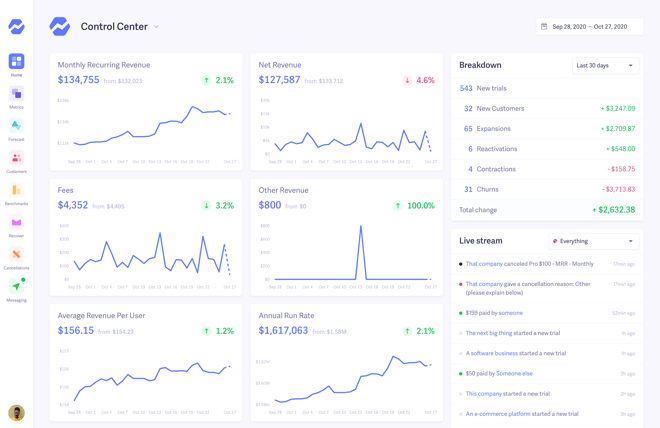For a subscription business, like a SaaS company, MRR is perhaps the single most important performance metric around. Trouble is, it isn't always as easy to determine, track and predict your MRR as it first appears.
Today, I'm taking a close look at how to (properly) calculate MRR and ARR.
The Importance of MRR
Most SaaS businesses work on a monthly subscription model: customers pay a fixed fee, each month, and for as long as they stay a customer, you have a predictable revenue source.
The recurring nature of this payment makes it (relatively) easy to track and forecast revenue, in a way that other business models would struggle to do. That's where MRR comes in: we can work out the amount of predictable revenue generated by our customers each month, known as Monthly Recurring Revenue.
If we have a good handle on customer acquisition and churn rates, we can even use that to extrapolate to the future, and predict future MRR.
HOW TO CALCULATE MRR
The basic formula for MRR is pretty simple: for any given month (period t), simply sum up the recurring revenue generated by that month's customers to arrive at your MRR figure.
MRRt = Σ Recurring Revenuet
In the example below, we have a monthly subscription cost of $200, and 2 customers in January. In February, we gain another customer, and MRR increases as a result:
January: 200 + 200 = $400 MRR
February: 200 + 200 + 200 = $600 MRR
March: 200 + 200 + 200 = $600 MRR
HOW TO CALCULATE ARR
Chances are when you see reference to MRR, ARR isn't far behind. That's because these metrics go hand-in-hand like fine wine and... well, annualised fine wine.
I've seen ARR referred to as both Annual Recurring Revenue and Annualized Run Rate, but the core calculation is the same either way.
Where MRR measures the recurring revenue generated each month, ARR measures the recurring revenue you'd generate over the course of a year. For forecasting purposes, ARR is used to predict annual recurring revenue for the coming 12 months, assuming no changes to your customer base.
As a result, the formula is pretty straight forward:
ARR = MRR * 12
If you're confused about when to use ARR instead of MRR, don't worry: ARR is typically the reserve of B2B SaaS companies, dealing primarily in annual contracts. If monthly subscriptions make up the bulk of your recurring revenue, you'll be better served by using MRR.
"...most enterprise SaaS companies should use annual recurring revenue (ARR), not monthly recurring revenue (MRR), because most enterprise companies are doing annual, not monthly, contracts..."Dave Kellog
How to Get MRR Right
Though the basic formula for MRR is extremely simple, many SaaS businesses include (or exclude) unnecessary data sources, and confuse their MRR calculations as a result.
Things to include in your MRR calculation:
- All recurring revenue from customers. This includes monthly subscription fees, and any additional recurring charges for extra users, seats, etc.
- Upgrades and downgrades. It's important to track any successful upselling, and any customers that downgrade to a lower-priced package.
- All lost recurring revenue. Customers churn, and this reduction in MRR needs to be accounted for.
- Discounts. If your customer is on a $200/month package, but pays a discounted monthly fee of $150, their MRR contribution is $150, not $200.
Things to exclude:
- Recurring costs. MRR isn't a measure of profitability, just revenue. We're trying to gauge trends in recurring revenue generation, and adding costs to this will only confuse matters.
- Bookings. This a common mistake, and warrants exploring in a little more depth.
The Confusion Between Bookings and MRR
MRR is relatively easy to calculate if all of your revenue comes from monthly subscriptions. But what happens if your customers want to pay for a year in advance?
In the example below, we have 3 customers, and a monthly charge of $200. While 2 of the customers pay monthly, the third pays for the whole year in advance.
If we treat the advance as MRR, our monthly reporting might look something like this:
January: 200 + 200 + 2400 = $2800 MRR
February: 200 + 200 + 0 = $400 MRR
March: 200 + 200 + 0 = $400 MRR
...
However that annual payment shouldn't be counted as MRR: it isn't paid monthly, and it isn't recurring.
The payment should instead be counted towards your Bookings figure: the total value of all new deals obtained over a particular time period, with no distinction between up-front and recurring payments.
Your Bookings figure is great for calculating cashflow, but MRR is a measure of recurring revenue generation. So to turn a booking into MRR, it needs to be amortized, and spread out over the year (in other words turned into a monthly, recurring payment):
January: 200 + 200 + (2400/12) = $600 MRR
February: 200 + 200 + (2400/12) = $600 MRR
March: 200 + 200 + (2400/12) = $600 MRR
...
If you're regularly on the receiving end of both monthly payments and annual payments, this can quickly confuse your MRR, and obscure real trends in your recurring revenue. And even if it sounds like an easy distinction to make, bookings/MRR confusion affects even the biggest and best SaaS businesses around.
Creating An MRR / ARR Calculation DASHBOARD
Now you know how to calculate your MRR / ARR / Bookings, want to create an automated dashboard to track them?
Something like this?
You can do this, and track other important SaaS growth metrics using Baremetrics. Their software is trusted by more than 900 SaaS companies.
Click here to start your free 14 day trial





